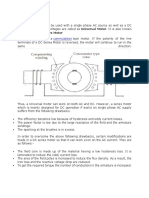Tutorial Questions (DC Motor) Q1
Uploaded by
Serwan BamerniTutorial Questions (DC Motor) Q1
Uploaded by
Serwan BamerniTutorial questions (DC motor)
Q1: A DC motor has a speed of (900 r.p.m) when connected to a (460 V) supply. Find the approximate
value of the speed of the motor when connected to a (200 V) supply, assuming the flux decreases by (30%)
and neglecting the armature volt drop? (Ans: 559 rpm)
Q2: A series motor has an armature resistance of (0.2 Ω) and a series field resistance of (0.3 Ω). It is
connected to a (240 V) supply and at a particular load runs at (1440 r.p.m) when drawing (15 A) from the
supply.
(a) Determine the back e.m.f at this load. (Ans: 232.5 V)
(b) Calculate the speed of motor when the load is changed such that the current is increased to (30 A).
Assume that this cases a doubling of flux. (Ans: 696.77 rpm)
Q3: A series motor runs at (800 r.p.m) when the voltage is (400 V) and the current is (25 A). The armature
resistance is (0.4 Ω) and the series field resistance is (0.2 Ω). Determine the resistance to be connected in
series to reduce the speed to (600 r.p.m) with same current. (Ans: 3.85 Ω)
Q4: On full-load a (300 V) series motor takes (90 A) and runs at (900 rp m) the armature resistance is (0.1
Ω) and the series winding resistance is (50 mΩ). Determine the speed when developing full load torque
but with a (0.2 Ω) diverter in parallel with the field winding. (assume that the flux is proportional to the
field current). (Ans: 1004.4 rpm)
Q5: A 10 HP 240 volts 1200 rpm dc shunt motor is operating at rated conditions. Determine the percent
change in shunt field flux required to lower the speed to 900 rpm. Assume that armature current remains
the same. (Ans: 33%)
Q6: A 200 volt shunt motor is rated a 5 HP and 1000 rpm at rated output it draws 25 A of line current.
The total armature circuit resistance is 0.5 ohms. The field resistance is 100 ohms.
a) Find the total rotational losses of the motor at rated conditions. (Ans: 605.5 W)
b) Find the no load speed of the motor at 200 volts. (Ans. 1053 rpm)
You might also like
- Chapter 15.1.2.3 DC Drives PPT II Spring 2012No ratings yetChapter 15.1.2.3 DC Drives PPT II Spring 201256 pages
- Lecture Notes Elec A6: Induction MachinesNo ratings yetLecture Notes Elec A6: Induction Machines39 pages
- Review Questions For Electrical Machines and Drives100% (1)Review Questions For Electrical Machines and Drives14 pages
- Equivalent Circuit and Phasor Diagrams of Synchronous Generator100% (1)Equivalent Circuit and Phasor Diagrams of Synchronous Generator10 pages
- EN 206: Power Electronics and Machines: Direct Current (DC) Machines100% (1)EN 206: Power Electronics and Machines: Direct Current (DC) Machines35 pages
- Parameter Identification and Modelling of Separately Excited DC MotorNo ratings yetParameter Identification and Modelling of Separately Excited DC Motor8 pages
- Practical - 3 - Four Quadrant Chopper Fed DC DriveNo ratings yetPractical - 3 - Four Quadrant Chopper Fed DC Drive15 pages
- EI6402 Electrical Machines Question BankNo ratings yetEI6402 Electrical Machines Question Bank19 pages
- Load Flow Matrices IIT Roorkee Notes NPTEL100% (1)Load Flow Matrices IIT Roorkee Notes NPTEL88 pages
- Unit - 2 Optimal Design of DC Machine Unit-02/Lecture-01No ratings yetUnit - 2 Optimal Design of DC Machine Unit-02/Lecture-0131 pages
- Solving DC Motors Simple Torque Problems PDFNo ratings yetSolving DC Motors Simple Torque Problems PDF8 pages
- DC Motors Starters and Breaking MethodsNo ratings yetDC Motors Starters and Breaking Methods25 pages
- Applications-Light Dimmer, Excitation System and Solar PV System in Phase Controlled Converters100% (1)Applications-Light Dimmer, Excitation System and Solar PV System in Phase Controlled Converters7 pages
- Unit V Design of Controllers For Drives: 3.1transfer Function For DC MotorNo ratings yetUnit V Design of Controllers For Drives: 3.1transfer Function For DC Motor12 pages
- Department of Electrical Engineering Indian Institute of Technology, Roorkee Roorkee EE - 101: Electrical Science Tutorial Sheet - 09No ratings yetDepartment of Electrical Engineering Indian Institute of Technology, Roorkee Roorkee EE - 101: Electrical Science Tutorial Sheet - 091 page
































































